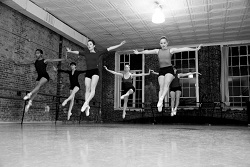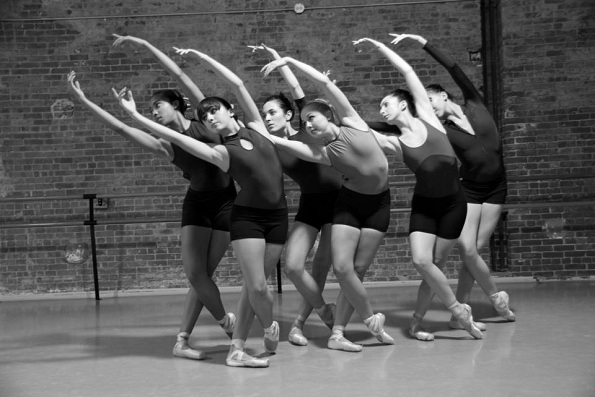By Leah Gerstenlauer.
New York is often billed as a city full of possibilities, a culture-rich artists’ playground teeming with creative potential. Yet, as many a professional and aspiring performer will attest, behind every marquee boasting opportunity lie countless closed doors, endless red tape and any number of other seemingly insurmountable obstacles that could discourage even the most tenacious dreamer. For every tale of smashing success, we see a hundred broken hearts and an ever-growing pool of untapped talent.
But what is a determined artist to do with unfulfilled aspirations and an excess of creative energy? “If opportunity doesn’t present itself, you just have to make your own,” says freelance dancer, choreographer and entrepreneur Morgan McEwen. Last fall, she experienced something of an epiphany while participating in a pick-up project for a choreographer with whom she frequently works. “I was involved in the CounterPointe Festival as a dancer, and I saw all these other women presenting their work… I started to wonder why I hadn’t choreographed something and submitted it.”
Thus emerged MorDance, McEwen’s budding ballet company, which will stage its first production on May 3 at Manhattan Movement and Arts Center. The group is comprised of seven dancers — their backgrounds ranging from college programs and city-based freelance work, to contracts with the Polish National Ballet and Orlando Ballet — whom McEwen has met over the course of her five years in the city. As is the case for many dancers in New York, she says, “They’re all beautiful artists, and they’re always looking for work.”
Having made a graceful transition from a steady company contract to a freelance career in 2008, the young choreographer knows just how formidable, and occasionally terrifying, the task of piecing together employment in her fiercely competitive and fickle industry can be. “At the time [I left BalletMet], I was 21 and wide-eyed, and had a dream of living the artistic life in New York. To some extent, I think I’ve succeeded. I’ve been working with the Metropolitan Opera for four and a half years now, I guest with small companies around the country, and I work with other choreographers in the city. If someone needs a dancer, I’m there.”

Morgan McEwen’s MorDance. Photos by Kelsey Campbell.
When not striving to maintain this intricate web of regular performance gigs, McEwen teaches ballet; a skill that she began to hone while still in high school and the gateway to her choreographic career. Since 2001, she has crafted works for the Connecticut Conservatory, Maria Calegari School of Ballet and the apprentices at Ballet Theatre of Maryland. Though she admits to no small degree of trepidation at baring her work to the world in the new context of a self-produced show, she affirms that she is more than ready to branch out on her own.
“As nervous as I am, I’m also extremely excited. I can’t wait to show people what I have in my head and in my body — I’m excited to share that. There’s anxiety about whether or not people are going to like it, and what’s going to be said… But you can’t really worry about that. You have to accept that people will take it or leave it, love it or hate it.”
Still quite young in spite of her nearly ten-year professional career, McEwen exudes laudable confidence, resourcefulness and drive. She attributes these traits in large part to a highly supportive circle of family, friends, and peers willing to provide everything from monetary gifts, to discounted rehearsal space and costuming skills to help bring MorDance to life. McEwen also absorbs ample encouragement by example from the creative community surrounding her.
“Working with the Met Opera, I share the stage not only with great dancers, but with people who are talented in other artistic ways. Walking onto that stage every night with an audience of thousands in front of you, and Renée Fleming singing next to you — it’s so inspiring.”
On a more personal level, McEwen counts Julia Gleich, founder and director of Gleich Dances, as a primary role model. “A lot of the time, choreographers don’t really seem to have a vision or are uncertain of it, but Julia is one hundred percent behind every idea she’s ever had. She’s completely fearless. She puts herself out there for everyone to see.”
Gleich particularly impresses McEwen, who regularly appears with Gleich Dances, as a significant female figure in a male-dominated arena. In the ballet world, creative and administrative roles still belong predominantly to men. McEwen hopes to follow Gleich’s lead in challenging that standard. “Artistic Directors are mainly male, most of the choreographers I look up to are men. I hope to become a small part of the female contingent in the field,” she says.
With a premiere performance date set, funding efforts picking up speed, and a collection of high-caliber dancers working in the wings, the founder of MorDance is well on her way to achieving that goal.
To learn more about Morgan McEwen and MorDance, visit http://morganclairemcewen.com/MorDance.html.
To support MorDance, visit www.indiegogo.com/MorDance?c=home.















